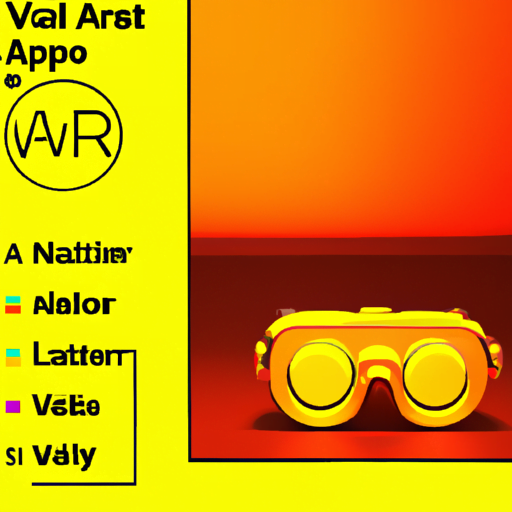
-
Table of Contents
- Interface Design for AR/VR Art and Design Experiences
- The Importance of Interface Design in AR/VR
- Principles of Interface Design for AR/VR
- 1. Clarity and Simplicity
- 2. Consistency
- 3. Feedback and Responsiveness
- 4. Contextual Design
- 5. User Testing and Iteration
- Examples and Case Studies
- 1. Tilt Brush by Google
- 2. The Museum of Other Realities
- Summary
Interface Design for AR/VR Art and Design Experiences

Augmented Reality (AR) and Virtual Reality (VR) have revolutionized the way we experience art and design. These immersive technologies have opened up new possibilities for artists and designers to create interactive and engaging experiences for their audiences. However, to fully harness the potential of AR/VR, it is crucial to have well-designed interfaces that enhance the user experience and enable seamless interaction. In this article, we will explore the importance of interface design for AR/VR art and design experiences, discuss key principles and best practices, and provide examples and case studies to illustrate the impact of effective interface design.
The Importance of Interface Design in AR/VR
Interface design plays a critical role in AR/VR experiences as it serves as the bridge between the user and the virtual world. A well-designed interface can make the difference between a captivating and immersive experience and a confusing and frustrating one. Here are some reasons why interface design is crucial in AR/VR:
- Intuitive Interaction: AR/VR interfaces should be intuitive and easy to use, allowing users to interact with the virtual environment effortlessly. A well-designed interface should minimize the learning curve and provide clear visual cues to guide users through the experience.
- Seamless Navigation: Navigation is a key aspect of AR/VR experiences, and a well-designed interface can make it seamless and intuitive. Users should be able to move around the virtual space, access different features, and interact with objects without feeling disoriented or overwhelmed.
- Enhanced Engagement: An effective interface design can enhance user engagement by providing interactive elements and intuitive controls. By enabling users to actively participate in the experience, interfaces can create a sense of agency and immersion.
- Accessibility: Accessibility is an important consideration in interface design for AR/VR. Interfaces should be designed to accommodate users with different abilities, ensuring that everyone can enjoy and engage with the art and design experiences.
Principles of Interface Design for AR/VR
When designing interfaces for AR/VR art and design experiences, several principles should be considered to create a seamless and immersive user experience. Let’s explore some of these principles:
1. Clarity and Simplicity
AR/VR interfaces should prioritize clarity and simplicity to avoid overwhelming users with complex visuals and interactions. Clear and concise instructions, minimalistic design elements, and intuitive navigation can help users understand and engage with the virtual environment more effectively.
2. Consistency
Consistency is crucial in interface design to provide users with a familiar and predictable experience. Consistent visual cues, interaction patterns, and navigation controls across different AR/VR art and design experiences can reduce cognitive load and enhance usability.
3. Feedback and Responsiveness
AR/VR interfaces should provide immediate feedback and responsiveness to user actions. Visual and auditory cues can inform users about the outcome of their interactions, creating a sense of presence and enhancing the overall experience.
4. Contextual Design
Contextual design involves tailoring the interface to the specific needs and characteristics of the AR/VR experience. Understanding the user’s context, such as the purpose of the experience, the target audience, and the environment in which it will be used, can help designers create interfaces that align with the overall goals and objectives.
5. User Testing and Iteration
Iterative design and user testing are essential in the development of AR/VR interfaces. By involving users in the design process, designers can gather valuable feedback and insights to refine and improve the interface design. User testing can help identify usability issues, understand user preferences, and ensure that the interface meets the needs and expectations of the target audience.
Examples and Case Studies
Let’s explore some examples and case studies that highlight the impact of effective interface design in AR/VR art and design experiences:
1. Tilt Brush by Google
Tilt Brush is a VR painting application developed by Google that allows users to create three-dimensional artworks in a virtual space. The interface design of Tilt Brush focuses on simplicity and intuitive interaction. Users can select different brushes, colors, and effects using handheld controllers, and their strokes appear as vibrant three-dimensional objects in the virtual environment. The interface provides real-time feedback, allowing users to see their creations come to life as they paint. Tilt Brush’s interface design enables artists to seamlessly transition from traditional painting techniques to the virtual world, unlocking new creative possibilities.
2. The Museum of Other Realities
The Museum of Other Realities (MOR) is a virtual art gallery that showcases immersive and interactive artworks created by artists from around the world. The interface design of MOR focuses on seamless navigation and enhanced engagement. Users can explore different exhibition spaces, interact with artworks, and even collaborate with other visitors in real-time. The interface provides intuitive controls and visual cues, allowing users to move around the virtual gallery effortlessly. The Museum of Other Realities demonstrates how effective interface design can transform the way we experience and engage with art.
Summary
Interface design plays a crucial role in AR/VR art and design experiences, enabling intuitive interaction, seamless navigation, enhanced engagement, and accessibility. By following key principles such as clarity and simplicity, consistency, feedback and responsiveness, contextual design, and user testing, designers can create interfaces that enhance the overall user experience. Examples like Tilt Brush and The Museum of Other Realities demonstrate the impact of effective interface design in unlocking the creative potential of AR/VR. As AR/VR technologies continue to evolve, interface design will play an increasingly important role in shaping immersive and engaging art and design experiences.
